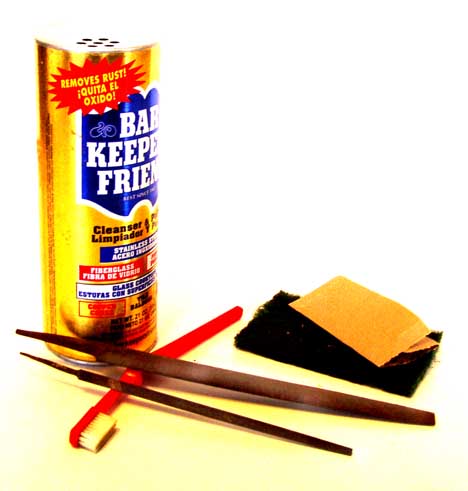 Most metals are available in different finishes. Raw or Mill Finished metals have a brushed finish. Sculptures, Jewelry
& Art pieces are almost always made of raw metal. It is then cleaned, polished
or coated after it has been soldered, welded, formed or worked. The metal can also be subsequently textured, painted or patinated. Most metals are available in different finishes. Raw or Mill Finished metals have a brushed finish. Sculptures, Jewelry
& Art pieces are almost always made of raw metal. It is then cleaned, polished
or coated after it has been soldered, welded, formed or worked. The metal can also be subsequently textured, painted or patinated.
-
- Novices often expect metals
in the raw state to have a finished surface and do not consider
the marring that may occur with creation of a piece; nor consider
that metal cannot be soldered, braised, or welded if there is
any coating on the metal. Precious metal suppliers are often
vexed by expedient beginners expecting to be shipped mirror finish
sheet and wire for crafting jewelry.
-
- The only metals
commonly in use that do not tarnish are fine stainless steel,
pure gold and platinum. We do not offer these due to difficulty
of working with stainless steel and the cost of gold and platinum. This aside, copper, brass, nickel &
aluminum will last a long time with some care. Objects of these
metals thousands of years old grace museums.
-
- Copper is a very reactive metal and will gain a natural patina with time like the Statue of Liberty. With a little care copper and alloys of metal containing copper such as brass and Nickel silver can be kept bright for a long time.
-
- First off, just as with sterling
silver, keeping metal dust free, in low humidity indoors goes
a long way. Avoiding harsh chemicals such as salt, salt air,
bleach will keep them from corroding.Finger prints can over time
even cause spots.
-
- Second cleaning with a good
gentle cleaner lasts long. Finally a coating of wax or clear
lacquer can last many years. See below for details.
-
 Cleaning
Copper, Brass, Aluminum and other metals. Cleaning
Copper, Brass, Aluminum and other metals.
-
-
- Copper and brass is easily
cleaned using materials and products found around the house.
The metal may retain an oily or greasy residue from its manufacture.
This residue can be removed using dish washing detergent with
a sponge or rag.
- Heavy oxidation or discoloration
has to be removed more aggressively using fine sand paper, abrasive
pads, abrasive cleansers or chemical tarnish removers. Many cleansers
(such as Bar Keeper's) contain an abrasive with a mild powdered
acid which activates in water and removes oxidation. Cleansers
containing bleach will remove the oxidation but the chlorine
in the mix can induce a green patina. A tooth brush can be used
to work the cleanser into folds or joints. DO NOT use steel wool
on copper or brass as the iron in the wool will transfer to the
metal and eventually cause a black discoloration. Abrasive methods
of cleaning will leave a 'brushed' satin finish on the metal
which can later be buffed to a polished finish.
 Commercial tarnish removers and metal
polishes are available for copper and brass. Follow the instructions
that come with these products. Commercial tarnish removers and metal
polishes are available for copper and brass. Follow the instructions
that come with these products.
 It is the nature of copper
and brass to tarnish or oxidize over time. As the oxidation progresses
it is referred to as 'patina' and is highly valued by some. The
green patina on the Statue of Liberty is an example of this. It is the nature of copper
and brass to tarnish or oxidize over time. As the oxidation progresses
it is referred to as 'patina' and is highly valued by some. The
green patina on the Statue of Liberty is an example of this.
- You can slow or inhibit
the formation of oxidation using paste wax or a clear lacquer
coating. There are specific brass and copper lacquers commercially
available that are purported to last longer. Incralac is used
by many sculptors use. One maker: CAP industries 543 Staunton
St, Piqua OH 45356 They may have to be removed and reapplied
if the metal tarnishes under the coating.
-
-
- Paste wax or Lacquer can be
applied to the cleaned bare metal once it has been thoroughly
dried. If moisture is trapped under the finish coating it will
tarnish. Coppersmiths in the 1800s used to pack the cleaned piece
in hot saw dust to remove the moisture. Today lighting fixture
and faucet manufacturers go to great lengths to prepare, clean
and dry their brass fixtures for the lacquer coating that keeps
them looking bright as long as possible. It is our experience
that a permanent clear coating for brass and copper is very difficult
if not impossible to obtain. Periodic cleaning and re-coating
is always necessary.
|